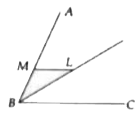In a triangle ABC, internal bisector of ∠ABC and external bisector of ∠ACB meet in D. Which one of the following is true ?
∠BDC=∠BAC
∠BDC=12∠ABC
∠BDC=∠DBC
None of these
The correct Answer is:D
To solve the problem, we need to analyze the triangle ABC and the angles formed by the internal bisector of angle ABC and the external bisector of angle ACB at point D. Let's break down the solution step by step.
Step 1: Understand the Configuration
We have triangle ABC with:
- Internal bisector of angle ABC meeting at point D.
- External bisector of angle ACB also meeting at point D.
Step 2: Define the Angles
Let:
- Angle A = ∠A
- Angle B = ∠B
- Angle C = ∠C
- Let the internal bisector of angle ABC create two angles at D: ∠ABD = ∠DBC = θ (since it is a bisector).
- The external bisector of angle ACB will create an external angle at point D, which we will denote as ∠ACD.
Step 3: Apply the External Angle Theorem
According to the external angle theorem:
- The external angle ∠ACD = ∠A + ∠B (since it is equal to the sum of the two opposite interior angles).
Step 4: Set Up the Equations
From the triangle ABC, we know:
- The sum of angles in triangle ABC is 180°:
∠A+∠B+∠C=180°
From the external angle theorem, we can express ∠ACD:
∠ACD=∠A+2θ
Step 5: Analyze Triangle BCD
In triangle BCD, we have:
- The angles are ∠BCD = ∠C, ∠BDC = θ, and ∠ACD = ∠A + 2θ.
- The sum of angles in triangle BCD is also 180°:
∠BDC+∠C+∠ACD=180°
Substituting the known values:
∠BDC+∠C+(∠A+2θ)=180°
Step 6: Substitute and Solve
From the previous equation of the sum of angles in triangle ABC:
∠C=180°−∠A−∠B
Substituting this into the equation for triangle BCD gives:
∠BDC+(180°−∠A−∠B)+(∠A+2θ)=180°
This simplifies to:
∠BDC+180°−∠B+2θ=180°
Thus:
∠BDC=∠B−2θ
Step 7: Relate Angles
From the earlier setup, we know:
- Since θ = ∠ABD = ∠DBC, we can say:
∠BDC=12∠ABC
Conclusion
After analyzing the angles and applying the external angle theorem, we find that:
∠BDC=12∠ABC
Thus, the correct option is:
BDC is equal to half of ABC.
We have triangle ABC with:
- Internal bisector of angle ABC meeting at point D.
- External bisector of angle ACB also meeting at point D.
Let:
- Angle A = ∠A
- Angle B = ∠B
- Angle C = ∠C
- Let the internal bisector of angle ABC create two angles at D: ∠ABD = ∠DBC = θ (since it is a bisector).
- The external bisector of angle ACB will create an external angle at point D, which we will denote as ∠ACD.
According to the external angle theorem:
- The external angle ∠ACD = ∠A + ∠B (since it is equal to the sum of the two opposite interior angles).
From the triangle ABC, we know:
- The sum of angles in triangle ABC is 180°:
∠A+∠B+∠C=180°
From the external angle theorem, we can express ∠ACD:
∠ACD=∠A+2θ
In triangle BCD, we have:
- The angles are ∠BCD = ∠C, ∠BDC = θ, and ∠ACD = ∠A + 2θ.
- The sum of angles in triangle BCD is also 180°:
∠BDC+∠C+∠ACD=180°
Substituting the known values:
∠BDC+∠C+(∠A+2θ)=180°
From the previous equation of the sum of angles in triangle ABC:
∠C=180°−∠A−∠B
Substituting this into the equation for triangle BCD gives:
∠BDC+(180°−∠A−∠B)+(∠A+2θ)=180°
This simplifies to:
∠BDC+180°−∠B+2θ=180°
Thus:
∠BDC=∠B−2θ
From the earlier setup, we know:
- Since θ = ∠ABD = ∠DBC, we can say:
∠BDC=12∠ABC
After analyzing the angles and applying the external angle theorem, we find that:
∠BDC=12∠ABC
BDC is equal to half of ABC.
Topper's Solved these Questions
- BOOK - LUCENT PUBLICATIONCHAPTER - CENTRE OF TRIANGLEEXERCISE - EXERCISE-6B8videos
CENTRE OF TRIANGLE
- BOOK - LUCENT PUBLICATIONCHAPTER - CENTRE OF TRIANGLEEXERCISE - EXERCISE-6B8videos
CENTRE OF TRIANGLE
- BOOK - LUCENT PUBLICATIONCHAPTER - ALGEBRAIC IDENTITIES EXERCISE - Exercise - 1B28videos
ALGEBRAIC IDENTITIES
- BOOK - LUCENT PUBLICATIONCHAPTER - CIRCLE AND ITS TANGENT LINESEXERCISE - EXERCISE 8B27videos
CIRCLE AND ITS TANGENT LINES
Similar Questions
Knowledge Check
- Question 1 - Select One or More
In a triangle, with usual notations, the length of the bisector of angle A is
A2bcb+csinA2B2bcb+ccosA2Cabc2R(b+c)cosecA2D4Ab+ccosecA2 - Question 2 - Select One
In a ΔABC, if the bisector of the angle BAC meets BC in D, then which one of the following is correct?
AAB≤BDB∠DBA>12∠BACCΔABD can never be isoscelesDIf BD=AD, then ΔABD will be equilateral. - Question 3 - Select One
If in a !ABC ,CD is the bisector of ∠ACB, then CD =
Aa+b2abcosC2Ba+babcosC2C2aba+bcosC2DbsinAsin(B+C2)
In triangle ABC,the bisector of interior angle A and the bisector angle C meet at point O. Prove that ∠AOC=12∠B
View SolutionProve that the angle between internal bisector of one base angle and the external bisector of the other base angle of a triangle is equal to one half of the vertical angle.
View SolutionProve that the angle between internal bisector of one base angle and the external bisector of the other base angle of a triangle is equal to one-half of the vertical angle.
View SolutionΔABC ,angle B external angle C meets at P ∠A=80 then ∠BPC = ?
View SolutionCF is the internal bisector of angle C of ΔABC then CF is equal to
View Solution


